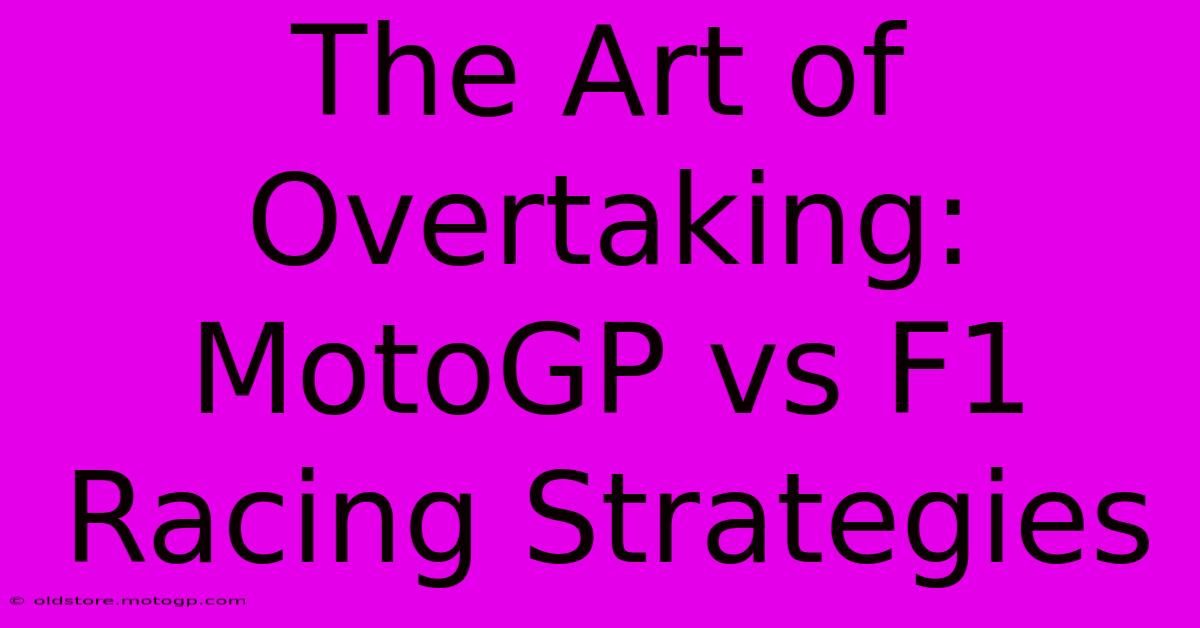The Art Of Overtaking: MotoGP Vs F1 Racing Strategies

Table of Contents
The Art of Overtaking: MotoGP vs F1 Racing Strategies
Overtaking. The heart-stopping moment of motorsport, where skill, strategy, and a touch of luck collide. But the art of overtaking differs dramatically between two of the most prestigious racing series in the world: MotoGP and Formula 1. While both feature high speeds and intense competition, the inherent differences in vehicle dynamics and track characteristics lead to vastly different overtaking strategies. This article delves into the nuances of overtaking in MotoGP and F1, comparing and contrasting the techniques employed by the world's best riders and drivers.
MotoGP: A Dance of Bravery and Precision
MotoGP bikes, with their lean angles and powerful engines, present a unique set of challenges and opportunities for overtaking. The lightweight nature of the bikes allows for rapid changes in direction, crucial for finding gaps and executing daring maneuvers.
Key Overtaking Strategies in MotoGP:
- Trail braking and late braking: MotoGP riders are masters of trail braking, using the brakes even while leaning into a corner. This allows them to carry more speed into the apex and emerge ahead of their rival. Late braking, a crucial aspect of this technique, requires exceptional precision and nerve.
- Aggressive corner entry: Taking the racing line aggressively, forcing the opponent to defend, is a common tactic. The speed and agility of the MotoGP machines allow for quicker corner exit speeds, offering overtaking opportunities.
- Drafting and slipstreaming: While less prevalent than in F1 due to the bikes' lower aerodynamic efficiency, drafting can still provide a small but significant speed advantage on straights, setting up an overtake.
- The 'pass' on the inside, outside, and even in between: The dexterity and maneuverability of the MotoGP bikes make seemingly impossible overtakes a reality. Riders often use a combination of aggressive braking and precise lines to exploit even the smallest gaps.
The Risk-Reward Equation: Overtaking in MotoGP is inherently riskier than in F1. The narrow tracks, high speeds, and lack of substantial run-off areas mean a mistake can have devastating consequences. This high-stakes environment demands not just skill, but also calculated risk assessment from the riders.
F1: Aerodynamics and Strategic Precision
Formula 1, with its technologically advanced cars and emphasis on aerodynamics, necessitates a different approach to overtaking. The downforce generated by these cars significantly impacts their ability to follow and overtake closely.
Key Overtaking Strategies in F1:
- DRS (Drag Reduction System): The DRS is a crucial overtaking aid in F1. It opens a flap on the rear wing, reducing drag and increasing straight-line speed, making overtakes much easier on the straights.
- Tire Management: Understanding tire degradation is paramount for an effective overtaking strategy. A driver can strategically utilize fresher tires to gain an advantage over a rival on worn tires.
- Strategic Pit Stops: Pit stops play a crucial role. An undercut (pitting before a rival and emerging ahead) or an overcut (staying out longer, allowing the rival to pit and emerge behind) can significantly impact race positions and create overtaking opportunities.
- Exploiting different braking points and racing lines: While less dramatic than in MotoGP, skilled drivers can still find small advantages by braking slightly later or using a different line through corners.
The Importance of Teamwork: F1 overtaking often relies on team strategy, with pit stops and race strategy designed to create opportunities. The precision and collaboration between the driver and the team are vital for successful overtaking maneuvers.
The Key Differences: A Summary
| Feature | MotoGP | F1 |
|---|---|---|
| Vehicle Dynamics | High agility, quick direction changes | High downforce, stable but less agile |
| Overtaking Style | Aggressive, precise, high-risk | Strategic, often aided by technology |
| Track Characteristics | Narrower tracks, less run-off areas | Wider tracks, more run-off areas |
| Key Overtaking Aids | Rider skill, precision braking | DRS, tire strategy, pit stop strategy |
Ultimately, both MotoGP and F1 demand exceptional skill and precision for successful overtaking. However, the approaches differ significantly, reflecting the unique characteristics of the machines and the racing environments. Whether it's the daring maneuvers of MotoGP or the calculated strategies of F1, the art of overtaking remains a thrilling spectacle that keeps fans on the edge of their seats.

Thank you for visiting our website wich cover about The Art Of Overtaking: MotoGP Vs F1 Racing Strategies. We hope the information provided has been useful to you. Feel free to contact us if you have any questions or need further assistance. See you next time and dont miss to bookmark.
Featured Posts
-
F1 Ratings Throughout History A Look Back At The Legends
Feb 23, 2025
-
Inside Track On Formula 1 Parking Secure Your Spot
Feb 23, 2025
-
The Hottest Us Gp Concerts This Year
Feb 23, 2025
-
Capture The Thrill Epic Moto Gp Photography
Feb 23, 2025
-
Cota Track Days Discover Your Riding Potential
Feb 23, 2025
